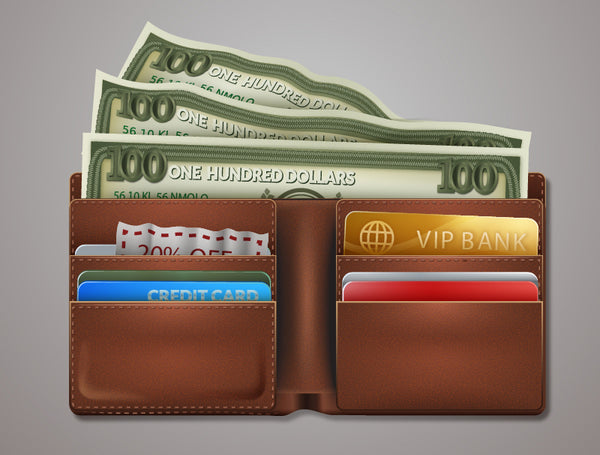You have no items in your shopping cart.



Society seems to be hell bent towards making us accumulate more and more stuff, and a lot of it ends up cluttering our wallets. Membership & discount cards, coupons, receipts, business cards, and multiple credit cards does not only create unnecessary bulk, but also creates a great security concern in case your wallet is lost or stolen. The good news is that there are some neat and easy ways to declutter your and rid yourself of the cards you didn’t think you could be without!
Decluttering your wallet and moving towards a minimalist wallet has many benefits, such as reducing potential security risks, making sure that your spending more strategic and organized, and facilitates using a nice slim wallet that doesn’t create unecessary bulk in your pocket. It even has significant health benefits, such as reducing common back ailments like sciatica.

A strong argument for decluttering your wallet: sitting on this brick will lead to painful back ailments over time.
Keep reading for the complete guide to becoming an Essentialist and getting a minimalist wallet.
Emptying out your wallet can be tough, depending on how much clutter is currently riding in your bulky billfold on a daily basis. You need discipline to get rid of the ATM receipts, Movie stubs and Restaurant receipts and basically anything that is nonessential. In fact, decluttering is a mindset, and one not always easily embraced!
“If you don’t need it, leave it at home”.
Hence, before you can embrace a minimalist wallet, you need to become an Essentialist. At the heart of the Essentialist lies the wisdom to discern from the nonessential. Those who cannot declutter remain snared in the death grip of the nonessential. The key mindset of an Essentialist is: If you don’t need it, leave it at home.

Decluttering starts by distinguishing the trivial from the essential and creates space, where we can explore, think and reflect and live a less stressful life.
Decluttering becomes a mindset. The action of getting rid of past junk creates space, where we can explore, think and reflect and live a life truer to ourselves. It starts by distinguishing the trivial from the essential.
The definition of Essentialism is set by famous designer Dieter Rams,”weniger aber besser”, which means less but better. Essentialism believes in your ability to choose, discriminate, take control and realize the unimportance of almost everything.
“You cannot overestimate the unimportance of practically everything” - John Maxwell
Social security card
This is the most important card to leave at home from a security standpoint because of how getting it stolen makes you very vulnerable to identity theft. Even the U.S. government's website recommends leaving your card at home in a safe place. Your Social Security number is only nine digits and should be memorized.
Credit cards & Business cards
Don’t carry every credit card you own because if your wallet is lost or stolen, a thief will have a field day with your cards and you won’t have anything to fall back on while you take care of getting new cards. Carry only one or two of your main cards, and possibly a back up. Remember the mindset: if you don't need it, leave it at home.
If you love to network and meet people, keeping your business card handy is a good idea. However, when other people's business cards are collected, transfer the information to your contact list or file them away.

Wallets with photos are more likely to be returned than wallets without photos, according to a 2009 study. Photos with a baby takes the lead—88 percent of wallets with baby photos were returned, so keep a photo in there, the extra bulk is actually worth it should you loose your wallet!
Membership cards
Don't carry gift cards around in the off-chance you'll pass by the store and decide to use it. If you wallet falls into the hands of a thief, gift cards can be first thing used, because they're just like cash. Leave them at home, unless you know you're going shopping at that store.
Afraid to loose membership/discount cards? Here’s a Bonus tip: A low tech way to store discount and membership cards while removing them physically from your wallet is to type in the barcode number from the card in an online barcode generator, and to simply print the numbers out and jot down the corresponding card it came from next to the code. These can then be pasted on a card you carry every day, (like a library card), and will be scannable when you hand it over to a cashier. Apps can do this to of course, but sometimes the store scanners have trouble reading the barcodes from your phone, and sometimes it’s just more fun to do things the old fashioned way!

Cut up your CVS, Walgreens, Rite-Aid, Autozone rewards cards and super glue them onto one card. This works for any bar-code card. (Don't cut up any rewards cards that must be swiped) or use an app like Keyringapp.
Social Security card, Password and PINs, Gift Cards, Receipts, and Coins
Any form of identity card that isn’t necessary on a daily basis, like a driver’s license or state ID or access card for work, should not be in your wallet unless you have a specific reason for it that day. This will protect your identity, and help declutter your wallet at the same time. Passwords and PIN-codes should be memorized as fast as possible and should not be kept near your cards for security reasons. Gift cards should only be brought if you are going to use them that day, receipts should be kept in a jar at home, and if you really need coins, try to limit them to a few to prevent them from creating bulky havoc in your wallet.
Quick fact: 1,000 wallets and purses are stolen every two minutes in America.
After you have emptied out your wallet and cleansed it of the most useless stuff, you need to identify your essential cards and carry. On a daily basis, you shouldn’t carry more than two credit cards (one primary and one back-up) and one debit card in your wallet at the same time. This doesn’t only limit access for pick pockets and wireless scanner-thieves, but keeping store cards at home will it spare your finances from impulse purchases that you might regret later and make your shopping more planned and organized.

Despite moving towards a cash-less society, small cash transactions, such as tipping and other small transactions will continue to be needed for the foreseeable future.
Keep some emergency cash at hand. Despite moving towards a cash-less society, small transactions will be dominated by cash for a long time to come and you never know when you might need it. But make sure to only carry enough you need to make the purchase you planned, with some margin of course.
Where do you draw the line on what to get rid of and what to keep? To make the decluttering process simpler, you can classify your cards into everyday carry cards, like the credit cards, and driver’s license, and some optional carry for planned purchases, like bringing rewards programs cards and punch cards for specific shopping excursions.

Keep: Some cash, two credit cards, one debit card, driver’s license.
Optional: Access cards, commuter cards, health insurance cards, rewards programs cards, punch cards.
Tip: Make a habit of regularly cleaning out your receipts at the end of the day/week.
The hardcore way of decluttering is simply to rid yourself of everything but the most essential, but then you’ll loose out on the membership deals and discounts for the odd times you do need it. There is a way around that and that is through digitizing your cards.
The processing power of one smartphone could technically be used to power 120 000 000 Apollo Era space missions; this awesome computing power can be utilized to downsize your daily carry with a range of handy apps designed for doing just that.

Use apps to digitize your paper items. Apps can help you remove those dreaded membership and loyalty cards that you feel that you might use one day, but you’re never quite sure when.
Keep your passwords stored in LastPass Password Manager, exchange your receipts with Expensify, and keep your thick wads of cash in the bank, using apple pay or android pay. If you want to carry less business cards, there’s even a many business card reader apps to choose from, such as camcard which helps you scan your business cards directly into the contacts on your iPhone. For membership and reward cards, apps like Keyring and Stocards loyalty card app can help you store the barcodes from these cards on your smartphone. There are many options to digitize your carry using that little supercomputer called the smartphone, and you should get started now to reduce the bulk without losing out on your discounts.
Problems & their digital solution:
Passwords – Solution: Lastpass Password Manager
Receipts – Solution: Expensify
Business Cards: Camcard free
Memebership cards: Keyring
Bonus tip: Once or twice a year, photocopy your most important cards. If you lose your wallet, it makes it easy to do all the required notifications.
Once you've gone through the steps, you have removed the unnecessary cards, digitized or printed the ones you need, you have one last thing to remove: your bulky billfold wallet. It is time to get a minimalist wallet that reflects your decluttered lifestyle.
The modern bifold wallet with multiple card slots became standardized in the early 1950s with the introduction of the first credit cards and remain extremely popular to this day, yet to fully embrace minimalist wallets, you need to rid yourself of it, and opt for a minimalist wallet, which is more similar to a card holder than a bifold.

The bifold has not changed it's design since its conception in the 1950s and is not conducive to minimalist carry.
With the move towards a cash free society with increased digitalization, the bifold is getting antiquated. Its designed has virtually had no changes since its conception in the 1950s and is not a great wallet for those of you looking to reduce your carry and become minimalists.

Once you have decluttered, you need a wallet that reflects your anti-clutter lifestyle. Here featured is front pocket wallets from Axess Front Wallets.
The good news is that the market is absolutely saturated with minimalist wallets. A quick search on Kickstarter returns over 1000+ wallets. Most wallets are mass produced “me-too”-products without specific benefits, but there are a few wallets that tend to specific needs depending on what you want.
A showcase on how thin a minimalist wallet remains even when stuffed with cards and cash.
There are metal wallets, wooden wallets, slim billfolds, unfolded wallets, card holders, in calf leather, in cow leather, etc. If you really want to have a minimalist wallet, you should opt for a tight seamless wallet that is made in one piece, to truly remove bulk. A billfold, no matter how slim, can never equal an unfolded wallet when it comes to a slim profile.
----------------------------------------------------------
← Older Post Newer Post →